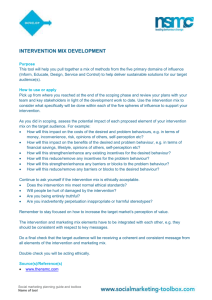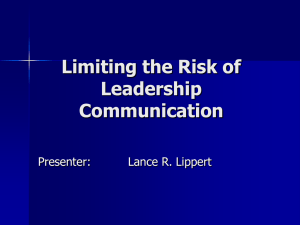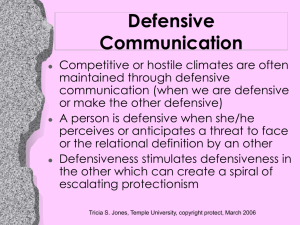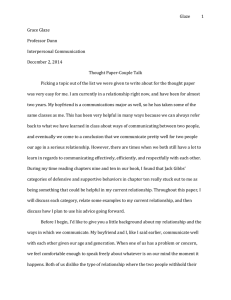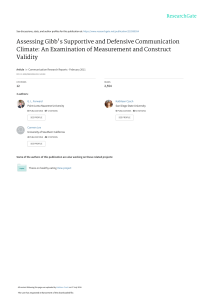As PDF
advertisement
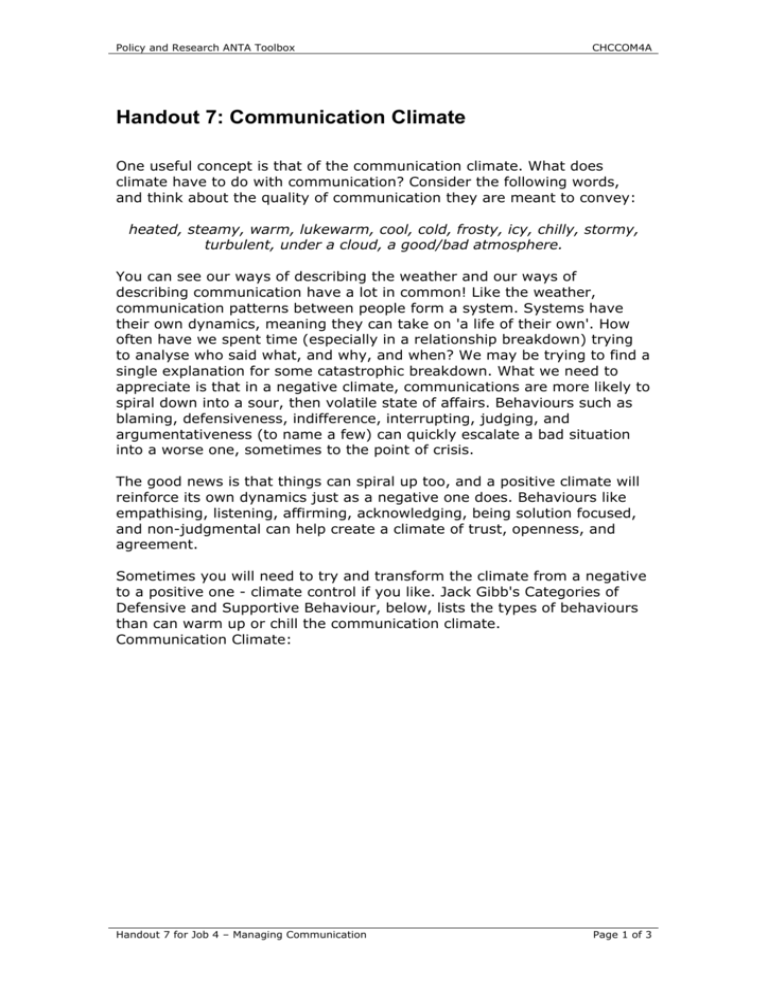
Policy and Research ANTA Toolbox CHCCOM4A Handout 7: Communication Climate One useful concept is that of the communication climate. What does climate have to do with communication? Consider the following words, and think about the quality of communication they are meant to convey: heated, steamy, warm, lukewarm, cool, cold, frosty, icy, chilly, stormy, turbulent, under a cloud, a good/bad atmosphere. You can see our ways of describing the weather and our ways of describing communication have a lot in common! Like the weather, communication patterns between people form a system. Systems have their own dynamics, meaning they can take on 'a life of their own'. How often have we spent time (especially in a relationship breakdown) trying to analyse who said what, and why, and when? We may be trying to find a single explanation for some catastrophic breakdown. What we need to appreciate is that in a negative climate, communications are more likely to spiral down into a sour, then volatile state of affairs. Behaviours such as blaming, defensiveness, indifference, interrupting, judging, and argumentativeness (to name a few) can quickly escalate a bad situation into a worse one, sometimes to the point of crisis. The good news is that things can spiral up too, and a positive climate will reinforce its own dynamics just as a negative one does. Behaviours like empathising, listening, affirming, acknowledging, being solution focused, and non-judgmental can help create a climate of trust, openness, and agreement. Sometimes you will need to try and transform the climate from a negative to a positive one - climate control if you like. Jack Gibb's Categories of Defensive and Supportive Behaviour, below, lists the types of behaviours than can warm up or chill the communication climate. Communication Climate: Handout 7 for Job 4 – Managing Communication Page 1 of 3 Policy and Research ANTA Toolbox CHCCOM4A Defensive and Supportive Message Behaviour A supportive communication climate encourages open, constructive, honest and effective interaction. A defensive climate, on the other hand, leads to competitive and destructive conflict. The competent communicator strives to maintain a supportive communication climate. Defensive Behaviour Supportive Behaviour Evaluative: Descriptive: The evaluative message is engulfed in judgement. The message can be blatantly evaluative or can carry non-verbal overtones of judgement. "When are you going to start coming to meetings prepared?" Control: Descriptive messages are clear and specific assertions. The creator of descriptive messages strives to avoid loaded words and is aware of non-verbal cues. Control messages are not honest attempts to persuade, but rather, attempts to impose one's will on others by coercion or manipulation? "If we knew what we were doing, we would..." Strategy: This message poses an invitation to the group to work together on finding a solution to a mutual problem. This approach focuses on the issues. Strategic messages convey an air of deceiving, or misleading. Although the receiver's perception plays a central role, speakers should attempt to avoid producing strategic messages. Neutrality: Spontaneous messages are characterised by openness and honesty. This forthright message indicates that the speaker's contribution is unplanned and free of ulterior motives. Empathy: The neutral message demonstrates a lack of empathy or interest "I don't care what this group does." The empathetic message is responsive to others' feelings and thoughts. It conveys understanding and interest. Equality: Superiority: These messages not only attempt to portray the speaker as superior but also imply the inferiority or inadequacy of the listener. These messages also discourage interaction since the speakers is indicating a lack of desire for input or feedback. Handout 7 for Job 4 – Managing Communication Problem Orientation: Spontaneity: These messages indicate worth in the other and in others' contributions. An equality message asks for others' input and follows up with confirmation or clarification of others' comments. Page 2 of 3 Policy and Research ANTA Toolbox CHCCOM4A Certainty: Provisionalism: Certainty messages portray something as an absolute. The creator of these messages sees the world in black and white, and believes to have a corner on the reality market. SOURCE: The provisional message poses a point of view, but with an open attitude. This is an invitation to investigate or explore alternatives. Gibb, J. (1961). Defensive communication. Journal of Communication, 11, 141-148. Handout 7 for Job 4 – Managing Communication Page 3 of 3







